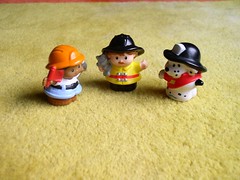Community Leadership in Learning – bees, mentors, coaches, experts and friends
 This is the sixth in a series of blog posts I wrote for Darren Sidnick. I am finally getting the rest of the series up. Part 1, part 2, part 3, part 4, part 5, part 6, part 7 , part 8 , part 9 and part 1o are all here on the blog.
This is the sixth in a series of blog posts I wrote for Darren Sidnick. I am finally getting the rest of the series up. Part 1, part 2, part 3, part 4, part 5, part 6, part 7 , part 8 , part 9 and part 1o are all here on the blog.
When we dream of community learning, we often have this idyllic fantasy that they justwork. Automagically things get organized. Participation happens. But when we open our eyes and think of the wasteland of fossilized or never-really-happened learning communities, of the dead web discussion forums, reality hits. While it may take a village or wider family to raise a child, it takes roles to raise a community. And unless you have endless time or deep pockets to pay someone (or some ONES) these roles have to be distributed across the community. Lets take a look at some possible roles in learning communities or communities of practice. These are examples, and they are in my language. You may very well have different labels and different roles in your community. The point is to be able to describe them. Then a community can begin to step in, negotiate, and fill the roles.
More than tutors and learners
At the moment many people think there is just the educational practitioner (expert; one role); and the learner. Teacher, student. Perhaps there is also the subject matter expert who comes in to create a course or determine the content pieces, and an instructional designer who organizes that content based on pedagogical principles and within the constraints of the technologies in use.
In reality, there are more roles. People often play more than one role or switch between roles. Some of these roles may be played by one person or many. Sometimes they are formalized (as in instructor) and sometimes they are entirely informal and ad hoc. It all depends on the context. Here are some examples. Notice the overlap!
- Subject matter expert – in CoP lingo, these are the people who have a sharp focus on the domain (see CoP Series #2). In self paced elearning, the experts made their appearance during
 the creation of the course, then are essentially gone. A tutor (see next description) may take on this role. In many learning communities, the members themselves are to some extent or another, also experts. This means as a value we explicitly recognize, value and use the knowlege of the learners. This can lead to peer mentoring or peer tutoring. As humans too, we generally appreciate being recognized. So this build social capital in a learning group.
the creation of the course, then are essentially gone. A tutor (see next description) may take on this role. In many learning communities, the members themselves are to some extent or another, also experts. This means as a value we explicitly recognize, value and use the knowlege of the learners. This can lead to peer mentoring or peer tutoring. As humans too, we generally appreciate being recognized. So this build social capital in a learning group. - Tutor – tutors help learners achieve the course objectives and support the individual’s learning objectives and practices. This is the more one-on-one support in traditional small cohorts, but can also be a role distributed amongst the learners as peer tutors, who can then be supported overall by the lead tutor or instructor. This builds capacity in the community as well as fulfills the tutoring function. Again, in CoP lingo, the tutor may be focused both on domain and it’s application: practice (see CoP Series #4)
- Technology steward – when we are learning together online, not everyone is as geeky as they might wish to be. The technology steward is a person who knows enough about the needs of the community and enough about the technology to help everyone use it well in learning together. This might be the person who naturally likes to experiment with web tools, or who is a good “explainer.” Tech stewards are often unaware they have this talent, so it is important to notice them and asking them to help. In an organizational setting, we rarely have enough “tech support” so these stewards within the learning communities can be a huge help.
- Community cultivator – These are the relationship people. In CoP lingo, they pay attention to community (see CoP Series #5) They welcome people into a learning group. They notice who might be interested in meeting others and makes the introductions. They notice when someone is missing. In an online environment where we lack many of our accustomed social signals (body language) this role is important. Look for the naturals – they love taking on this role. Technology can assist this role through the use of course member directories, social networking tools and even instant messengers.
 Content scanners and filterers – we talk about information overload. These people see it as a candy store. They scan, notice and often love to share what they have found. Set up tools and places for these folks to bring in external resources into your course. We’ll talk more about the HOW of doing this in a subsequent blog post.
Content scanners and filterers – we talk about information overload. These people see it as a candy store. They scan, notice and often love to share what they have found. Set up tools and places for these folks to bring in external resources into your course. We’ll talk more about the HOW of doing this in a subsequent blog post.- Content creators – History has shown that between 1% and 10% of participants in online groups produce 90- 99% of the content. In a course situation, we often want to increase this as a way to know if people are participating. (See Lurkers below). In reality, if everyone produced, we’d not be able to consume it. We’d choke. However, look for those who create value. Encourage them, like the content scanners, to lead conversations, share their critical thinking skills and role model active participation. Often just recognizing their skills encourages them.
- Lurkers – As CoP theory notes, some of us learn from the side, not in the center creating content, or leading conversations. This “legitimate peripheral participation” is often labeled “lurking” in online communities. Lurking means they are reading, but we just don’t know it. So we need to encourage people to give us clues if they are happily lurking, or find out if they are disconnected and lost. This takes us back to the tutors and peer tutors.
- Bridgers out to the world – Most learning within a course is the first step. Carrying that learning out into the world and applying it is the gold standard of success. It is my personal belief that nearly every course that has practical application as its goal should have an explicit activity that bridges out to the world. That may mean pointing out open learning communities interested in the same topic or domain, bringing in external speakers to add a touch of the “real world” or keeping learners connected after a course to support that learning in application. Members of the community can help create those links.
Not all of these roles have to be institutionalised. If you are providing elearning services, think about which ones are most important in your context. Prioritise the ones you can fill, then design your learning communities to support members taking on the other roles. This includes making space to talk about them, and recognising — even rewarding — people who take them on. Roles are a way for people to build their social capital. They another layer of identity for members in their communities. They cultivate a sense of ownership. The can raise the visibility and reputation of those who take them on successfully. So while roles most often equate with work, they also have intrinsic value to both the individual and the community.
Resources:
- Etienne Wenger: http://www.co-i-l.com/coil/knowledge-garden/cop/lss.shtml Scroll down to the section on leadership
- Bronwyn Stuckey and John Smith, Sustaining Communities of practice http://www.bronwyn.ws/publications/papers/sustaining.pdf
Image Credits on Flickr/Creative Commons
 The word “tinkering” keeps coming up to my radar screen, and it makes me happy. I love the idea of tinkering and find it central to the practice of
The word “tinkering” keeps coming up to my radar screen, and it makes me happy. I love the idea of tinkering and find it central to the practice of  Alex Soojung-Kim Pang
Alex Soojung-Kim Pang 

